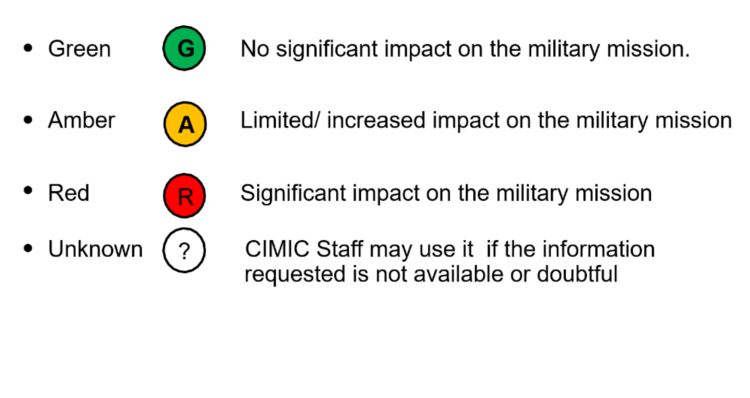VI. Execution
6.3. Reporting
The Reporting of CIMIC Information is one of the most essential tasks of CIMIC personnel. The aim is to deliver essential information that has an impact on the mission and commanders intent. Information will come from a variety of sources and is subsequently evaluated and standardized to reporting formats by CIMIC staff and distributed throughout the chain of command. CIMIC staff will continuously monitor the civil environment in order to estimate/assess the current situation and the impact on the operation as well as prepare assessment of situation development (for more information see Chapter 5.3 and the annex).
Reports and returns (R2)
Reports produced by CIMIC cells should be based on the same sets of rules as CIMIC estimates/assessments. CIMIC reports have to be:
- Accurate. Bear in mind - inaccurate information may be more dangerous than no information at all.
- Consistent. An absence of consistency will hamper the identification of key capability gaps and areas of potential concern.
- Timely. Provide commander with information he needs when he needs it.
- Relevant. Your resources are limited - do not waste time on work that does not affect the mission.
- Continuous. Mechanism or capability factored into the process that will enable staff to monitor and provide updates as necessary. In particular, emphasis should be placed on identifying progress and concerns relating to the most critical information requirements.
- Cooperative. Military staff, through the CIMIC liaison and co-ordination architecture, should attempt to utilise civilian sources of information. Additionally, it is also be of benefit for the military to share information of mutual interest with the relevant civil entities.
CIMIC has to be able to prepare comprehensive reports according to CIMIC TTP 1 and/or national requirements/mission driven requirements.
The amount of data collected during ongoing missions is vast and difficult to process properly. A proper reporting system has to be supported by proper data bases (collection, storage and back up). Make sure your data is supporting your work. At the same time ensure others to whom your data are important have easy access (SharePoint, sharedrive).
Brief but detailed reporting is critical on all levels for getting the essential message through. However, within multinational forces, different national and international formats will occur. Therefore CIMIC (staff officer) must be flexible in approach to R2 system. In all phases of operation (especially in early phase) it is of utmost importance to identify problems that could have a direct impact on the execution of the mission. Some of them are related to basic needs of the population (water, sanitation, power, health, food), other may be related to political or social (cultural, religion) domains.
Reports in general are divided into different areas: (for examples see the annex )
- Time scheduled standardized reports (CIMIC report);
- Reports on meetings and activities (liason report, after action report);
- CIMIC analysis and assessment (products) covering functional areas, working groups products (e.g. CIMIC contribution to the situational awareness briefing (SAB));
An initial default tool for reporting is the CIMIC reporting and tracking system (). CRTS was initially prepared for non-Article 5 crisis response operations (NA5CRO), but can be adapted to various situations.
A very good example of assesment and potential critical factors that may have direct impact on the mission can be seen in the Sphere Standards (The Sphere Project) and should also be used as the baseline for any military assessment in this area.
The CRTS provides cohesive way of processing data which enables CIMIC and non-CIMIC staff to view information on the civil environment with a common focus, in a simple and visible manner. CRTS elements are:
- CIMIC reports and returns (CIMIC reporting requirements);
- CIMIC operational overview (visual overview tool);
- Command level briefing tool (standard format presentation);
- CIMIC database (database higly likely will be set up by the higher HQ).
CRTS employs general rules for colour indicators used:

For examples of CRTS format see the annex.
Working groups
CIMIC personnel on certain levels (usually corps and higher) will lead or participate in various working groups as a part of the regular battle rhythm. The most important value of working groups is multidimensional approach to certain areas through participation of SME from different branches. Products of working groups may be distributed internally in the headquarters (as an observation /LI) or sent to higher (lower) echelons as a part of the reporting (assessment) flow of documents.
- 33
CIMIC tactics, techniques and procedures publication (AM 86-1-1)/TTP1
